
Point Pelee Part 6: Killdeer - Wild Turkey
May 23rd, 2010
Killdeer: The adorable common breeding plover. Though they're shorebirds by definition, killdeers often live inland: in Virginia and Carolina, I see them on commercial lawns and at the edges of parking lots, even with their young. The ones I saw during the trip, though, were mostly near Lake Erie. They nested on the shore and in the grass just beyond it.
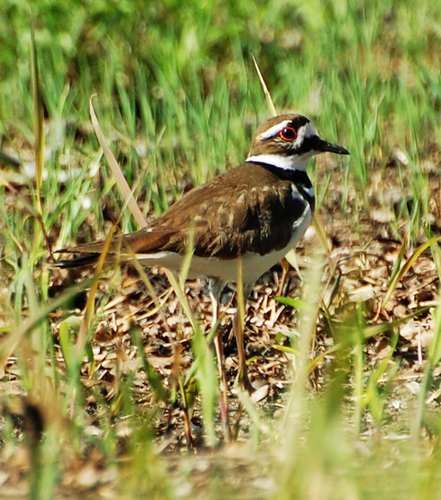
Northern Rough-Winged Swallow: This species apparently breeds in Thickson Woods. They were a common sight and sound there. Rough-Winged Swallows nest in burrows, often dug into stream banks.
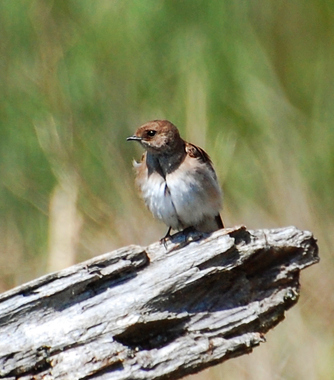
Orchard Oriole: Practically the first bird I saw, when we got off the bus at Point Pelee, was my first Orchard Oriole. I'd been looking forward to them. They're closely related (congeneric) to Baltimore Orioles, with similar patterning, but in place of the vivid orange breast, the male Orchard Oriole has deep chestnut. Quite handsome. The juvenile males are striking too: bright yellow with black throats.
Orchard Orioles are common at Point Pelee. They're one of the comparatively few species who actually breed there, as opposed to just passing through. Unfortunately they seem to be much less common in other nearby areas: I never had the opportunity to photograph one.
Red Admiral: This migrant butterfly has been moving through in unusual numbers this spring, both at Point Pelee and here in Ottawa. I photographed this one at Rondeau Provincial Park.
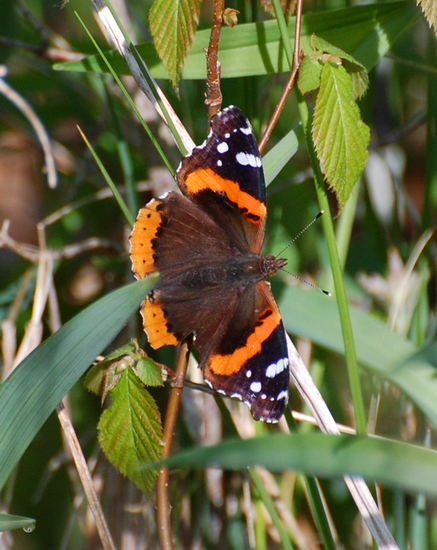
Scarlet Tanager: Seen and thoroughly enjoyed at both Pelee and Rondeau. Scarlet Tanagers are the birds who are redder than red, who blaze red, who put cardinals to shame. They are in our area--they breed in the Gatineau, for instance--but I seldom chance to see them.
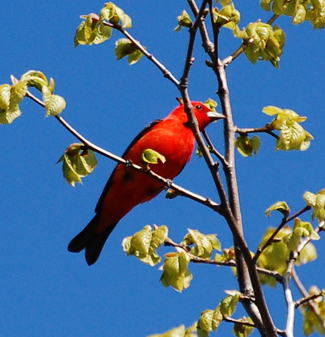
The Scarlet Tanager's southern cousin, the Summer Tanager, is also bright red and also occurs in far-south Ontario, but I don't think any of us found one.
Trumpeter Swan: A pair of them was in the distance at the Oshawa Marsh, viewable only by spotting scope. Their white plumage was heavily stained with rust, which apparently is common in this species because of the mineral-rich wetlands in which they forage. Lifer.
Veery: A tawny brown thrush with a beautiful, musical waterfall of a song. I and another photographer attempted to shoot him through a chain fence, and both found it tricky. I finally managed to get a half-decent shot by putting my camera on manual focus.
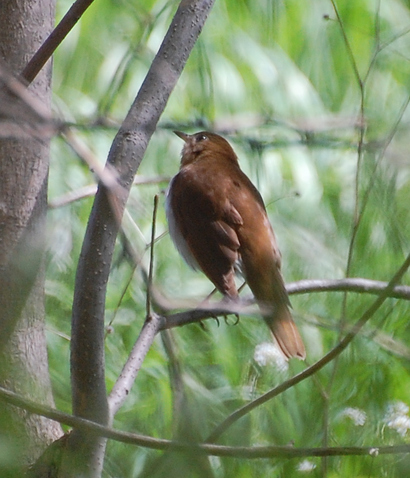
Wild Turkey: Saw a female on the nest at Tilden Woods! Very well-hidden in the underbrush, barely visible. Also had two toms walk by in the same area.
Thus ends the saga of Point Pelee. My next big extravaganza will be my parents' annual summer trip to Cape Hatteras, which Michael and I are taking part in. I'll be bringing the zoom lens there for the first time. Black-Necked Stilts, here I come :-)
May 23rd, 2010
Killdeer: The adorable common breeding plover. Though they're shorebirds by definition, killdeers often live inland: in Virginia and Carolina, I see them on commercial lawns and at the edges of parking lots, even with their young. The ones I saw during the trip, though, were mostly near Lake Erie. They nested on the shore and in the grass just beyond it.

Northern Rough-Winged Swallow: This species apparently breeds in Thickson Woods. They were a common sight and sound there. Rough-Winged Swallows nest in burrows, often dug into stream banks.

Orchard Oriole: Practically the first bird I saw, when we got off the bus at Point Pelee, was my first Orchard Oriole. I'd been looking forward to them. They're closely related (congeneric) to Baltimore Orioles, with similar patterning, but in place of the vivid orange breast, the male Orchard Oriole has deep chestnut. Quite handsome. The juvenile males are striking too: bright yellow with black throats.
Orchard Orioles are common at Point Pelee. They're one of the comparatively few species who actually breed there, as opposed to just passing through. Unfortunately they seem to be much less common in other nearby areas: I never had the opportunity to photograph one.
Red Admiral: This migrant butterfly has been moving through in unusual numbers this spring, both at Point Pelee and here in Ottawa. I photographed this one at Rondeau Provincial Park.

Scarlet Tanager: Seen and thoroughly enjoyed at both Pelee and Rondeau. Scarlet Tanagers are the birds who are redder than red, who blaze red, who put cardinals to shame. They are in our area--they breed in the Gatineau, for instance--but I seldom chance to see them.

The Scarlet Tanager's southern cousin, the Summer Tanager, is also bright red and also occurs in far-south Ontario, but I don't think any of us found one.
Trumpeter Swan: A pair of them was in the distance at the Oshawa Marsh, viewable only by spotting scope. Their white plumage was heavily stained with rust, which apparently is common in this species because of the mineral-rich wetlands in which they forage. Lifer.
Veery: A tawny brown thrush with a beautiful, musical waterfall of a song. I and another photographer attempted to shoot him through a chain fence, and both found it tricky. I finally managed to get a half-decent shot by putting my camera on manual focus.

Wild Turkey: Saw a female on the nest at Tilden Woods! Very well-hidden in the underbrush, barely visible. Also had two toms walk by in the same area.
Thus ends the saga of Point Pelee. My next big extravaganza will be my parents' annual summer trip to Cape Hatteras, which Michael and I are taking part in. I'll be bringing the zoom lens there for the first time. Black-Necked Stilts, here I come :-)
| ← | → |
